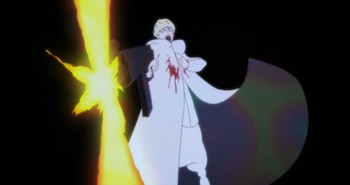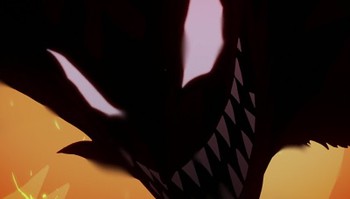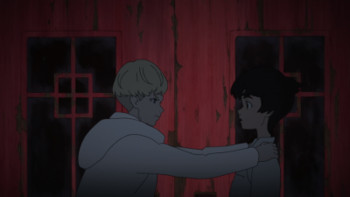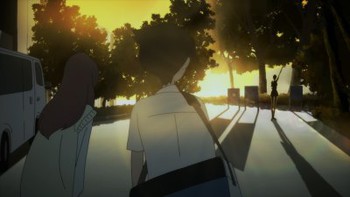The Winter 2018 Anime Preview Guide
Devilman Crybaby
How would you rate episode 1 of
DEVILMAN crybaby (ONA) ?
Community score: 4.2
What is this?

Akira is as sweet and kind as they come. As a little boy he cried over kittens he couldn't save, much to his friend Ryo's amazement – if he knew the kitten was going to die, why was he sad? It's not like it was unexpected. The two grow apart as Akira continues through school and Ryo moves to the US, where he becomes a professor involved in specialized research. When his fellow researcher, Professor Fikira, becomes possessed by a devil while working with indigenous people in South America, Ryo becomes obsessed with the idea of proving that devils are real. Returning to Japan, he seeks out Akira and deliberately takes him to a club where he knows devils lurk, inviting the devil Amon to possess his unwitting friend. There's no way this could possibly backfire, right? Devilman Crybaby is the latest incarnation of Go Nagai's Devilman manga, now available in its entirety on Netflix.
How was the first episode?

Jacob Chapman
Rating: 4
Unpopular opinion time: I have at best liked but just never loved Masaaki Yuasa's work. While I firmly believe he's a genius animator, and I always enjoy just looking at his uniquely mesmerizing sequences, the stories he chooses to tell in that style have never resonated with me on any deeper level than "that looks neat". I feel like I'm forever held at an ethereal arm's length from whatever human intimacy he's trying to communicate, simply enjoying the surreal beauty of his style until the story ends and I'm left remembering specific images and plot details without really feeling some type of way about them. From Ping Pong to Kaiba, Yuasa always seems to leave me intellectually intrigued but emotionally indifferent.
So thank god I don't have to don my thinking cap or tune my heartstrings for the balls-out, titty-waggling Devilman Crybaby.
Based on the infamously XXX-grade Go Nagai manga, this is Yuasa's take on a story synonymous with the hyperviolent OVA boom of the late '80s, boasting an extremely simple (yet somehow poorly-explained) premise that only exists as an excuse for wildly dated monster designs to rip women open from the crotch up, leaving their possessed vagina dentatas to rip men's heads off and shower the audience with fountains of blood. It's that kind of anime, taking Yuasa's superflat and hyper-fluid animation style back to his TV anime debut in Kemonozume: sex and violence at machspeed, if you will.
There's not much to say beyond that. If you like jaw-dropping imaginative animation and seedy sordid shameful stuff, you'll eat this up. The story is absurdly easy to follow and the characters easy to understand (especially by Yuasa standards), but the adult content bar for entry is high. Definitely don't check this one out in public. At the same time, I also found that Yuasa's super-cartoony style made it easy to stomach even the most horrifyingly lurid material in the episode. The episode's most graphic scenes of women mutating into bone-crunching sex demons seemed downright cuddly compared to most of the hyper-real horror of last year's Made in Abyss, for example. But maybe that's just me. Anyway, this is a visually arresting sleazefest with a great soundtrack. Come in expecting nothing more than that, and you'll have a great time.

Theron Martin
Rating: 3
There is one thing that I can say with confidence about this new adaptation of Go Nagai's classic manga: you won't see a more dramatic or outlandish visual spectacle in anime this season, and it's already putting a solid claim in for the yearly title. Whether or not that actually makes this series good is something that will depend much, much more on individual tastes.
As a director, Masaaki Yuasa is practically a god to some animation fans, but I have so little cared for his past efforts that I don't think I've ever even watched a second episode of any of them. His style is, without question, wildly inventive and experimental; he's willing to take risks that most would not. That's not the kind of approach that I like, but even so, I was curious to see what he would do with a title that revels in sex and gore. It didn't disappoint, though it took until the party scene near the end to actually impress me. Prior to that point, my response to the first episode was mostly “yeah, he's doing some different things, but this isn't particularly attractive art, so whatever.” That sequence though, where everyone goes demonic and crazy, was an eye-opener. Much more than anything else in the first episode, it showed the full potential of what he can do with a story like this. If you have a very high tolerance for blood, gore, and body horror, you owe it to yourself to check these last few minutes out.
That being said, I may not watch more of this because the net artistic effect is still a negative for me, the story isn't doing anything special, and I already dislike Ryo more than I'm probably supposed to at this point. I also had to look askance at some of the weird inclusions here, like the group of rappers who seemed intent on hitting on Miki. That was a pretty bizarrely random inclusion, even though they did fill the role of “random guys who hit on the protagonist's girl.” So was Ryo just pulling a machine gun out of his coat to deal with them; seemed a silly bit of overkill, though perhaps that was the intent. Those are balanced out by some occasional other sharp scenes, and don't let it be said that Yuasa doesn't know how to make blood splatter effective.
Since this is a Netflix release, it comes with an English dub available, one that is well-cast and well-performed so far even if it did skip on dubbing the rapping. But that's ultimately an irrelevant detail, as this is a series that will make-or-break on what you think about its look. So far I find the positives and negatives about its look to balance out.

James Beckett
Rating: 4.5
I have no experience with Go Nagai's Devilman manga franchise, and the only work of director Masaki Yuasa's that I've seen was his guest director spot for a 2014 episode of Adventure Time, so I had absolutely no idea what to expect going in to this new Netflix series, Devilman Crybaby. Coming out of the first of the ten episodes that have been released, I still don't really have a grasp on what I just watched, but the experience was so visceral, unique, and just plain bonkers that I absolutely have to keep watching, if only to see where things could possibly go from here.
From what I understand, the plot here is being adapted from the original 1972 manga, though its tone, style, and overall aesthetic is very much of the 21st century. Masaki Yuasa's unique style is the most immediately jarring and captivating thing about this show; before any of the plot or characters begin to gel together into something coherent (which isn't until about halfway through the episode), the show's hyper-flat, consistently shifting animation combined with the extremely expressive color and lighting palettes on display produce an effect that is equal parts mesmerizing, surreal, and horrifying. I found the first half of the episode to be a little bit sloppy in its scripting, with characters relationships to each other and the actual goings on of certain scenes feeling a bit nebulous and unclear, but the strength of the episode's visual direction was enough to pull me through to where the show goes truly bonkers.
Our poor hero, Akira, ends up being dragged to a decadent party by his manic friend, Ryo, whose research overseas has him convinced that there are demons living among the mortals of the world. Ostensibly trying to document proof of his findings, Ryo and Akira descend into Sabbath, a drug-fueled orgy of lights, color, and brazen sexuality that is captured with perfectly hedonistic incoherence by Yuasa and the crew at Studio Science SARU, and that's before everyone's bodies behind transmogrifying into delightfully insane abominations of genitals, gnashing teeth, and undying appetites. Seriously, this is the kind of absurdly trashy body-horror that shows like GARO -VANISHING LINE- could only dream of producing, and I almost couldn't believe that Netflix was willing to give this team the money to animate such a bizarre and graphic fever dream. Let there be no doubt: Devilman Crybaby is one-hundred percent Adults Only entertainment, and kudos to Netflix for allowing this team to truly run wild and craft their own unique vision for adapting Nagai's work, even at the risk of alienating anyone looking for a more traditional and digestible viewing experience.
And “experience” really is the word to describe the first episode of Devilman Crybaby; its plot is only just beginning to be sketched out, and its characters are just as nebulous. All we know is that Ryo has some less than savory ulterior motives, given that he is willing ruthlessly murder anyone in his way, and is all too eager to have his innocent friend Akira play host to some unspeakable demonic power. I can hardly even begin to guess at what these motives might be, and how the story is going to play out over the next nine episodes, but Devilman Crybaby's first episode is just so insanely confident in its presentation and execution that I can't help but be on board for whatever craziness is on the menu for the remainder of the season.

Nick Creamer
Rating: 3.5
Oh Yuasa, you make my life so difficult.
Masaaki Yuasa is one of the greatest living anime directors. Actually, that's putting it too lightly - Masaaki Yuasa is one of the greatest living directors, and his preferred medium happens to be animation. From Mind Game to The Tatami Galaxy to Ping Pong, his works represent the kaleidoscopic potential of animation, demonstrating both a vibrant core aesthetic sensibility and a determination to embrace innovation and creativity wherever possible. He's a genius, and we're all lucky to have him.
Yuasa's latest, Devilman Crybaby, reimagines the classic Go Nagai manga in the way only Yuasa could. This first episode is an utter visual buffet, cramming so many dramatically charged compositions and creative ideas into its twenty minutes that I felt almost overwhelmed by its bounty. From the melting watercolors of the opening song through the stark cliffside composition of Ryo and Akira's dramatically heightened childhood, Crybaby opens with a proud statement of purpose and never lets up. Each major sequence seems like it's built around one phenomenal core idea; one segment relies entirely on barely-there headlights to evoke the shape of a car at night, while a later twilight sequence is made transcendent through its unified yellow-themed palette and distinct character outlines. One later scene feels like the entirety of Apocalypse Now condensed into thirty seconds, and this premiere's final segment reaches heights of violence and debauchery only attainable through Netflix's forgiving patronage.
That final sequence is pretty indicative of why this episode leaves me so conflicted. On the one hand, Yuasa's work is an eternal balm for my soul. On the other hand, I have virtually zero interest in Go Nagai's campy, ultraviolent base material. Go Nagai's work embodies a hot-blooded aesthetic that was revelatory several decades ago, brimming with sex and drugs and every other transgressive topic available. There's a clear audience for that sort of stuff, but absent some strong emotional center or thematic purpose, sex and violence just tends to wear me out. This episode's lengthy, blood-soaked climax was sort of interesting in terms of its blended animation styles, but content-wise, I'd far prefer Yuasa's skills be applied to material like the quietly evocative track scenes that highlighted the episode's first half. Watching boob monsters eat people's heads is just not my scene.
Personal distaste for ultraviolence aside, there were moments throughout this episode where the underlying narrative seemed to chafe against its luscious framing. Very little of Ryo's dialogue felt like anything any human being would ever say, and his devil-centric exposition dump felt clumsy and archetypal relative to the incredibly lived-in scenes directly preceding it. There is a lot to love about this first episode, but at the moment, I'm pretty much enjoying it in spite of its narrative. I'm always happy to see Yuasa again, but that's a frustrating place to be.
 Lynzee Loveridge
Lynzee LoveridgeRating: 4
I approached the first episode of Devilman crybaby with some trepidation. This is a franchise known for reveling in its sexualized violence and I came away from Devilman Grimoire more than a little sick to my stomach as a result. On the other hand, this Netflix exclusive title is helmed by the esteemed director Masaaki Yuasa, whose signature style (violent or not) is always enthralling. The result is a viscerally artistic achievement, and while I still can't ignore the themes in the premiere episode's final act, the episode is unlike anything else airing this season.
The screen time is overflowing with narrative threads and often borders on over the top of ridiculousness. Is the high school track coach a senile frog person or possessed by a demon? Did the up and coming track star murder his coach when he was accused of doping? How did Ryo manage to get a machine gun past customs? It doesn't really matter. This show is here to be bombastic. I'm sure the first two questions will play out, but the fact that Ryo is completely unhinged and Akira is naive to the point of being an idiot is just part of the wild ride.
The roller coaster reaches the tippy top of its biggest drop in the last act when everything turns into a technicolor orgy of twerking T&A. This is when the show's monsters come out to play and also where the show loses its point from me. Despite being visual trip unlike any other, it's obvious the undercurrent of demonizing female sexuality is still as present as ever. Prior to Amon's awakening, Ryo manages to successfully awaken the dormant monsters in the sex club and, surprise, they're all female and, double surprise, their demon characteristics are all based around their sex organs which are promptly used to devour the men.
So while I'm somewhat impressed in how many ways the episode manages to makes breasts and vaginas into gnashing mouths, I can't help but let out a sigh of disappointment. Vagina monsters are great, but I'd appreciate some dick monsters too, otherwise the message here all seems blatantly skewed in one direction.

Rebecca Silverman
Rating: 3
Remember how your parents always told you to choose your friends wisely? That's something Akira really ought to have listened to. As a little boy he befriended Ryo, a kid who appeared to have little, if any, grasp on basic human emotions, and although the two took different paths in life, Ryo's appearance and Akira's willingness to just trust a guy who shows up after ten years with a machine gun in his coat does not turn out well for him. Ladies and gentlemen, welcome to the antithesis of all of those soothing cute girl shows that have debuted thus far: Devilman Crybaby.
It's very safe to say that this is not a show for the kiddies. There's a lot of gratuitous sex and violence, and the two are generally put together in scenes so over-the-top that it's clear that we're meant to see them as a sort of grand guignol, a circus of the macabre. When Ryo shows up in his shiny white car and whisks still-sweet Akira away, he takes him to an underground club where a new party drug is making the rounds, one which takes away all inhibitions. The scenes there, even before the devils show up, are psychedelic, both in the colors and the actions of the people there. This continues when the devils come out to play – things are so grotesque and overdone that there's just this sense of spectacle rather than horror – which of course is a horror in and of itself. As we admire the creativity (or laugh at the giant vagina monsters with their dripping tongues), there's a small voice reminding us that we're actually watching a massacre.
That's not to say that this is an artistic masterpiece, although there are some very good uses of color and imagery, particularly how black is generally reserved for darkness to the point where outlines are done in grays. There's a definite sense that this episode is trying a little too hard to shock and/or thrill the viewer, and the juxtaposition between Akira and Ryo is too obvious. The sexualized monsters are more laughable than anything, which may be the point, such as when one woman's breasts each turn into separate mouths. All in all Devilman Crybaby looks like a decent take on the original story, albeit too steeped in gratuitousness for me. If you're a fan of Nagai or are just looking for something more violent than what's on offer so far, this is worth checking out.
discuss this in the forum (623 posts) |
this article has been modified since it was originally posted; see change history
back to The Winter 2018 Anime Preview Guide
Season Preview Guide homepage / archives